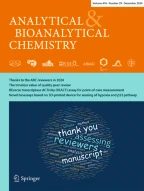1610Accesses
3Altmetric
Abstract
Application of matrix-assisted laser-desorption ionization mass spectrometry (MALDI-MS) to small-molecule detection is often limited, because of high matrix background signals in the low-mass region. We report here an approach in which a mixture of two conventional MALDI matrices with different proton affinity was used to suppress the formation of matrix clusters and fragments. Specifically, when acidic α-cyano-4-hydroxycinnamic acid (CHCA) and basic 9-aminoacridine (9-AA) were used as the binary matrix, fewer background matrix peaks were observed in both positive and negative-mode detection of small molecules. In addition, the presence of CHCA substantially reduced the laser fluence needed for analyte desorption and ionization; thus better signal-to-background ratios were observed for negatively charged inositol phosphates in complex plant extracts.

The mixing of MALDI matrices of different protonaffinities leads to suppression of matrix clusterformation and subsequently yields cleaner MS spectraof fewer background peaks in both positive andnegative detection of small molecules
This is a preview of subscription content,log in via an institution to check access.
Access this article
Subscribe and save
- Get 10 units per month
- Download Article/Chapter or eBook
- 1 Unit = 1 Article or 1 Chapter
- Cancel anytime
Buy Now
Price includes VAT (Japan)
Instant access to the full article PDF.





Similar content being viewed by others
Explore related subjects
Discover the latest articles and news from researchers in related subjects, suggested using machine learning.Reference
Cohen LH, Gusev AI (2002) Anal Bioanal Chem 373:571–586
Chan TWD, Colburn AW, Derrick PJ (1991) Org Mass Spectrom 26:342–344
McCombie G, Knochenmuss R (2004) Anal Chem 76:4990–4997
Knochenmuss R, Dubois F, Dale MJ, Zenobi R (1996) Rapid Commun Mass Spectrom 10:871–877
Knochenmuss R, Karbach V, Wiesli U, Breuker K, Zenobi R (1998) Rapid Commun Mass Spectrom 12:529–534
Cheng S-W, Chan TWD (1996) Rapid Commun Mass Spectrom 10:907–910
Asara JM, Allison J (1999) Anal Chem 71:2866–2870
Simmons TA, Limbach PA (1997) Rapid Commun Mass Spectrom 11:567–572
Dale M, Knochenmuss R, Zenobi R (1997) Rapid Commun Mass Spectrom 11:136–142
Kjellstroem S, Jensen ON (2004) Anal Chem 76:5109–5117
Smirnov IP, Zhu X, Taylor T, Huang Y, Ross P, Papayanopoulos IA, Martin SA, Pappin DJ (2004) Anal Chem 76:2958–2965
Kim J-S, Kim J-Y, Kim H-J (2005) Anal Chem 77:7483–7488
Vaidyanathan S, Gaskell S, Goodacre R (2006) Rapid Commun Mass Spectrom 20:1192–1198
Sakore TD, Jain SC, Tsai C-C, Sobell HM (1977) PNAS 74:188–192
Garcia BA, Heaney PJ, Tang K (2002) Anal Chem 74:2083–2091
Krutchinesky AN, Chait BT (2002) J Am Soc Mass Spectrom 13:129–134
Vermillion-Salsbury RL, Hercules DM (2002) Rapid Commun Mass Spectrom 16:1575–1581
Muller M, Schiller J, Petkovic M, Oehrl W, Heinze R, Wetzker R, Arnold K, Arnhold J (2001) Chem Phys Lipids 110:151–164
Jørgensen TJD, Bojesen G, Rahbek-Nielsen H (1998) Eur Mass Spectrom 4:39–45
Rak J, Blazejowski J, Zauhar RJ (1992) J Org Chem 57:3720–3725
Moncelli MR, Becucci L, Guidelli R (1994) Biophys J 66:1969–1980
Walton TJ, Hughes SY (1993) Rapid Commun Mass Spectrom 7:555–560
Acknowledgement
We would like to thank Drs Wendy Boss, Imara Perera, and Yang-Ju Im in the Department of Botany at NCSU for their kind help in plant extract preparation.
Author information
Authors and Affiliations
Department of Chemistry, North Carolina State University, Raleigh, NC, 27695, USA
Zhong Guo & Lin He
- Zhong Guo
You can also search for this author inPubMed Google Scholar
- Lin He
You can also search for this author inPubMed Google Scholar
Corresponding author
Correspondence toLin He.
Rights and permissions
About this article
Cite this article
Guo, Z., He, L. A binary matrix for background suppression in MALDI-MS of small molecules.Anal Bioanal Chem387, 1939–1944 (2007). https://doi.org/10.1007/s00216-006-1100-3
Received:
Revised:
Accepted:
Published:
Issue Date:
Share this article
Anyone you share the following link with will be able to read this content:
Sorry, a shareable link is not currently available for this article.
Provided by the Springer Nature SharedIt content-sharing initiative


